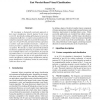Free Online Productivity Tools
i2Speak
i2Symbol
i2OCR
iTex2Img
iWeb2Print
iWeb2Shot
i2Type
iPdf2Split
iPdf2Merge
i2Bopomofo
i2Arabic
i2Style
i2Image
i2PDF
iLatex2Rtf
Sci2ools
CORR
2008
Springer
2008
Springer
Fast Wavelet-Based Visual Classification
We investigate a biologically motivated approach to fast visual classification, directly inspired by the recent work [13]. Specifically, trading-off biological accuracy for computational efficiency, we explore using standard wavelet transforms and patch transforms to parallel the tuning of visual cortex V1 and V4 cells, alternated with max operations to achieve scale and translation invariance. A feature selection procedure is applied during learning to accelerate recognition. We introduce a simple attention-like feedback mechanism, significantly improving recognition and robustness in multiple-object scenes. In experiments, the proposed algorithm achieves or exceeds state-of-the-art performance in object recognition, but also in new applications such as texture classification, satellite image classification, and language identification. Preliminary results on sound classification are shown as well.
CORR 2008 | Education | Feature Selection Procedure | Simple Attention-like Feedback | Trading-off Biological Accuracy |
| Added | 09 Dec 2010 |
| Updated | 09 Dec 2010 |
| Type | Journal |
| Year | 2008 |
| Where | CORR |
| Authors | Guoshen Yu, Jean-Jacques E. Slotine |
Comments (0)

